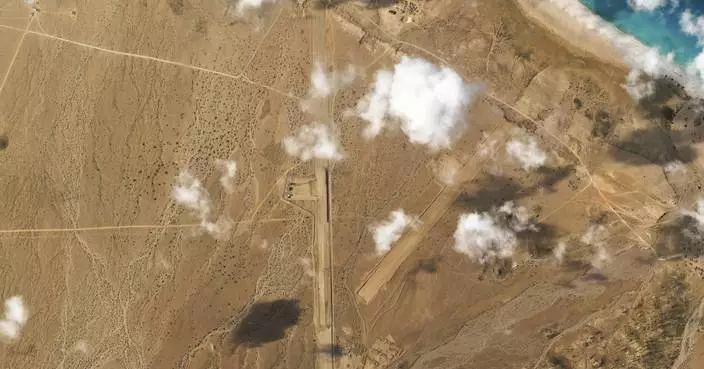At a cemetery in Yemen’s largest southern city, dozens of fresh graves were a testament to a spike in deaths amid the coronavirus pandemic.
The cemetery workers who bury them don’t know what killed the newly deceased. But there’s no denying that there's been an increasing number of people getting sick in the port city of Aden — likely from the coronavirus.
Many are buried with few precautions and only a small number of attendees. Workers wear masks or cover their faces with a cloth.
Mohammed Ebeid, a gravedigger in Aden, said there's been five times the normal traffic, with 51 burials in the last week.
“This is something strange, we’ve never seen it before,” he told The Associated Press late last week.
The international aid group Doctors Without Borders has reported a spike in deaths and infections from coronavirus, including health workers at a facility it runs in the city. Residents of Aden had previously said several hospitals shut their doors, as health care workers feared contracting the virus while lacking protective equipment.
The spike has also exposed the extent of the virus's spread in the war-torn country.
Caroline Seguin, Doctors Without Borders’ operations manager for Yemen, told the AP on Friday that the mortality rate at their facility treating COVID-19 patients was “very, very high,” and that a lot of people have arrived “almost dead, or already dead.”
The group, which is known by its French acronym MSF, said in a statement last week that the high number of deaths at its COVID-19 treatment center in Aden “speaks to a wider catastrophe unfolding in the city.” The key southern port has recently witnessed a new chapter of political infighting between and government forces and southern separatists who declared self-rule last month, leaving health authorizes in disarray.
The facility had no choice but to turn away patients, said Seguin, because they did not have enough staff and supplies to treat the patients. MSF’s facility is the only dedicated COVID-19 center for all of southern Yemen.
Seguin said at least 40 health workers at the facility were COVID-19 patients or suspected patients, but MSF couldn't confirm because of a shortage of tests.
The group said Thursday that "as many as 80 people have been dying in the city per day during the past week, up from a pre-outbreak normal of 10."
Earlier this month, the United Nations said it was extremely concerned by the rapid spread of the virus in Yemen. It said community transmission was going widely undetected, and unmitigated in many places, due to the lack of testing.
The Health Ministry of Yemen's internationally recognized government, which controls Aden, has reported only 212 confirmed cases including 39 deaths in the southern Yemen, which is low. In the north, which is controlled by the Houthi rebels, the numbers are even lower, but there are reports of unexplained deaths there as well. So far, the Houthis have reported four cases, including one death of a Somali migrant.
The Iran-backed Houthis captured much of northern Yemen in 2014, including the capital, Sanaa, forcing the government to flee to the south. The following year, a Saudi-led coalition went to war against the rebels.
That coffee you slurped this morning? It’s 600,000 years old.
Using genes from coffee plants around the world, researchers built a family tree for the world's most popular type of coffee, known to scientists as Coffea arabica and to coffee lovers simply as “arabica.”
The researchers, hoping to learn more about the plants to better protect them from pests and climate change, found that the species emerged around 600,000 years ago through natural crossbreeding of two other coffee species.
“In other words, prior to any intervention from man,” said Victor Albert, a biologist at the University at Buffalo who co-led the study.
These wild coffee plants originated in Ethiopia but are thought to have been first roasted and brewed primarily in Yemen starting in the 1400s. In the 1600s, Indian monk Baba Budan is fabled to have smuggled seven raw coffee beans back to his homeland from Yemen, laying the foundation for coffee’s global takeover.
Arabica coffee, prized for its smooth and relatively sweet flavor, now makes up 60% - 70% of the global coffee market and is brewed by brands such as Starbucks, Tim Horton's and Dunkin'. The rest is robusta, a stronger and more bitter coffee made from one of arabica's parents, Coffea canephora.
To piece together arabica coffee’s past, researchers studied genomes of C. canephora, another parent called Coffea eugenioides, and more than 30 different arabica plants, including a sample from the 1700s — courtesy of the Natural History Museum in London — that Swedish naturalist Carl Linnaeus used to name the plant.
The study was published Monday in the journal Nature Genetics. Researchers from Nestlé, which owns several coffee brands, contributed to the study.
The arabica plant’s population fluctuated over thousands of years before humans began cultivating it, flourishing during warm, wet periods and suffering through dry ones. These lean times created so-called population bottlenecks, when only a small number of genetically similar plants survived.
Today, that renders arabica coffee plants more vulnerable to diseases like coffee leaf rust, which cause billions of dollars in losses every year. The researchers explored the makeup of one arabica variety that is resistant to coffee leaf rust, highlighting sections of its genetic code that could help protect the plant.
The study clarifies how arabica came to be and spotlights clues that could help safeguard the crop, said Fabian Echeverria, an adviser for the Center for Coffee Research and Education at Texas A&M University who was not involved with the research.
Exploring arabica’s past and present could yield insight into keeping coffee plants healthy – and coffee cups full – for future early mornings.
The Associated Press Health and Science Department receives support from the Howard Hughes Medical Institute’s Science and Educational Media Group. The AP is solely responsible for all content.

FILE - Mohammed Fita picks coffee beans on his farm Choche, near Jimma, 375 kilometers (234 miles) southwest of Addis Ababa, Ethiopia, on Saturday, Sept. 21 2002. Wild coffee plants originated in Ethiopia but are thought to have been primarily roasted and brewed in Yemen starting in the 1400s. (AP Photo/Sayyid Azim, File)

FILE - Arabica coffee beans harvested the previous year are stored at a coffee plantation in Ciudad Vieja, Guatemala, on May 22, 2014. In a study published in the journal Nature Genetics on Monday, April 15, 2024, researchers estimate that Coffea arabica came to be from natural crossbreeding of two other coffee species over 600,000 years ago. (AP Photo/Moises Castillo, File)






